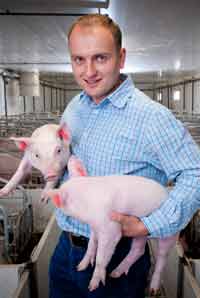Preview of 2011: Keeping on top of costs is key

Key industry figures give their views on the year ahead.
Andrew McCrea
“For 2011 the challenge to keep on top of the cost of producing my pigs seems never more relevant.
I recently attended a meeting of 25 other committed pig producers from Northern Ireland arranged by Dr Mark Hawe (FW Adviser of the year 2008) and pig specialist Liz Donnelly.
Leading the discussion was pig vet John Carr. He asked how we measure sow production? We came up with the usual, pigs a sow a year, farrowing rates, born alive.
“John pointed out while these figures are a guide to how production may be going, having a consistent flow of production may be more profitable than trying to hit the dizzy heights of 30 pigs a sow a year. Having one empty farrowing pen may cost £500 in lost production in one batch.
Reducing costs that I can control may be a good place for me to look at again in 2011, as well as focussing on maximising sow and pig space and concentrating on those costs.”
William Worsley
President of Country Land and Business Association
“The rural sector is more exposed than others to climate, weather and biological shocks. Globalisation and climate change now bring surprises each year, constantly testing the traditional resilience of farmers and will no doubt test further in 2011. To date, farmers have been less affected by the credit and financial crises.
Unfortunately, we cannot expect this insulation to survive and the impacts of DEFRA’s 30% cuts will be felt next year.
Apart from the changes in environmental stewardship schemes, cuts are likely to be made through “sharing” more animal health costs, although I sincerely hope this will be offset by real action in bovine TB control. There are big-ticket policy changes afoot with the CAP reform debate now well underway, the overhaul of the UK planning system and an environment white paper in preparation.
All of these could, and should, benefit farming but without very careful engagement from farming organisations, all three could backfire.”
Rob Clayton
Potato Council director
“Potato growers always respond in the spring to previous prices. Right now prices are relatively firm and higher than in previous years. I would expect to see areas creep up as the “speculators” respond by increasing planting. It brings to the sector a degree of volatility we could well do without.
A harsh winter usually knocks out a big chunk of our spring problems like volunteers and aphid populations. Time will tell but we’ve had enough below-zero days to set us up for a relatively low risk start to the season.
We are a sector that continues to rationalise and I can’t see that changing in the coming year but we should now start to be able to capitalise on the supportive messages embedded in key documents this year. The DEFRA Fruit and Vegetable Task Force is a great example.
If recommendations are followed we will start to see the health benefits and role of potatoes in the diet promoted more positively.”
